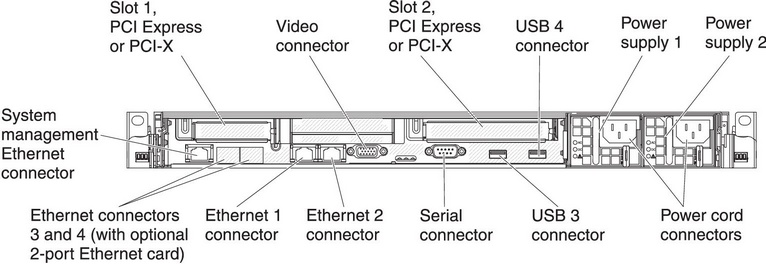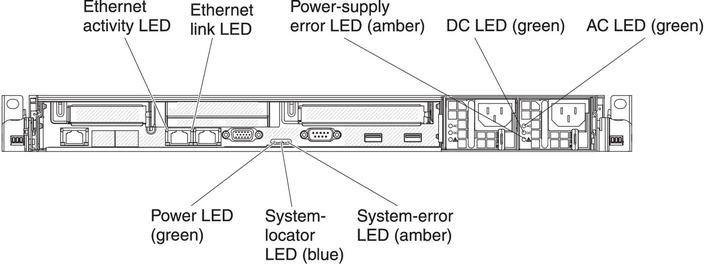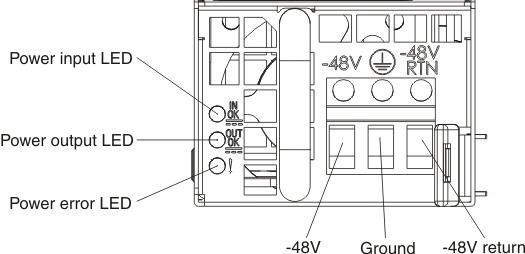Rear view
Use this information to view the controls, LEDs, and connectors on the rear of the server.
The following illustration shows the connectors and LEDs on the rear of the server.
Figure 1. Rear view


- PCI slot 1: Insert a low-profile PCI Express or PCI-X adapter into this slot. You can purchase an optional PCI Express or PCI-X riser-card assembly with bracket if you want to install a PCI adapter in this slot.
- PCI slot 2: Insert a half-length, full-height PCI Express or PCI-X adapter into this slot. Standard models of the server come with one PCI Express riser-card assembly installed in this slot. You can purchase an optional PCI-X riser-card assembly with bracket if you want to install a PCI-X adapter in this slot.
- Power cord connector: Connect the power cord to this connector.
- Video connector: Connect a monitor to this connector. The video connectors on the front and rear of the server can be used simultaneously.NoteThe maximum video resolution is 1600 x 1200 at 75 Hz.
- Serial connector: Connect a 9-pin serial device to this connector. The serial port is shared with the integrated management module (IMM). The IMM can take control of the shared serial port to perform text console redirection and to redirect serial traffic, using Serial over LAN (SOL).
- USB connectors: Connect a USB device, such as a USB mouse or keyboard to any of these connectors.
- Systems-management Ethernet connector: Use this connector to connect the server to a network for full systems-management information control.
- Ethernet connectors: Use either of these connectors to connect the server to a network. When you use the Ethernet 1 connector, the network can be shared with the IMM through a single network cable.
The following illustration shows the LEDs on the rear of the server.
Figure 2. Rear view LEDs


The following illustration shows the LEDs on a dc power supply.
Figure 3. DC power supply LEDs


- Ethernet activity LEDs: When these LEDs are lit, they indicate that the server is transmitting to or receiving signals from the Ethernet LAN that is connected to the Ethernet port.
- Ethernet link LEDs: When these LEDs are lit, they indicate that there is an active link connection on the 10BASE-T, 100BASE-TX, or 1000BASE-TX interface for the Ethernet port.
- AC power LED: Each hot-swap ac power supply has an ac power LED and a dc power LED. When the ac power LED is lit, it indicates that sufficient power is coming into the power supply through the power cord. During typical operation, both the ac and dc power LEDs are lit. For any other combination of LEDs, see Power-supply LEDs.
- IN OK power LED: Each hot-swap dc power supply has an IN OK power LED and an OUT OK power LED. When the IN OK power LED is lit, it indicates that sufficient power is coming into the power supply through the power cord. During typical operation, both the IN OK and OUT OK power LEDs are lit. For any other combination of LEDs, see Power-supply LEDs.
- DC power LED: Each hot-swap power supply has a dc power LED and an ac power LED. When the dc power LED is lit, it indicates that the power supply is supplying adequate dc power to the system. During typical operation, both the ac and dc power LEDs are lit. For any other combination of LEDs, see Power-supply LEDs.
- OUT OK power LED: Each hot-swap dc power supply has an IN OK power LED and an OUT OK power LED. When the OUT OK power LED is lit, it indicates that the power supply is supplying adequate dc power to the system. During typical operation, both the IN OK and OUT OK power LEDs are lit. For any other combination of LEDs, see Power-supply LEDs.
- Power-supply error LED: When the power-supply error LED is lit, it indicates that the power supply has failed.NotePower supply 1 is the default/primary power supply. If power supply 1 fails, you must replace the power supply immediately.
- System-error LED: When this LED is lit, it indicates that a system error has occurred. An LED on the light path diagnostics panel is also lit to help isolate the error.
- Power-on LED: When this LED is lit and not flashing, it indicates that the server is turned on. The states of the power-on LED are as follows:
- Off: Power is not present, or the power supply or the LED itself has failed.
- Flashing rapidly (4 times per second): The server is turned off and is not ready to be turned on. The power-control button is disabled. This will last approximately 20 to 40 seconds.
- Flashing slowly (once per second): The server is turned off and is ready to be turned on. You can press the power-control button to turn on the server.
- Lit: The server is turned on.
- Fading on and off: The server is in a reduced-power state. To wake the server, press the power-control button or use the IMM web interface. See Logging on to the Web interface for information on logging on to the IMM web interface.
- System-locator LED: Use this LED to visually locate the server among other servers. You can use IBM Systems Director to light this LED remotely.
Give documentation feedback